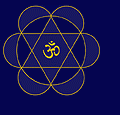The roots of yoga are located in ancient India, early traces can be dated back to 3000 years BC. The first teachings were already passed on in the Veda (Sanskrit: "knowledge"), first orally, later they were also written down. Over the last five thousand years yoga has been - and still is - an essential element of the Indian culture and it is still lively practised and taught today.
The Sanskrit term "yoga" literally translated means "yoke" - that one with which you put cattle to a carriage. From a symbolical point of view, "yoga" could on one hand be translated to "integration" or "union", on the other hand it can be understood in the meaning of "regulation" and "connection" of the human energies. Yoga thus is a path through which body and life energy are brought together by practice, and through which the forces of nature are regulated in such a manner that harmony grows. Understood that way, yoga is a continuous process of learning and development which includes all the aspects of life. Often it can be found today that yoga is only associated with physical exercise, the so called asanas. But regarding the tradition of yoga it can be seen that the asanas are a means to the aim of meditation: Through all the exercises body and mind are to be guided to harmony and longer periods of undisturbed meditation become possible. Yoga thus is a science of health and healing, as well as a pathway for personal growth and spiritual experience.
The oldest systematic scripture of yoga-teachings is delivered in the Yoga-Sutra of Patanjali. These are 195 short aphorisms in which the essence of yoga is concentrated. The exact lifetime of Patanjali is not known, different researches conclude that the Yoga-Sutra were developed between 500 and 200 BC. But more important are the contents of the Yoga-Sutra, up until today they are considered as one of the most important scriptures concerning yoga and they still provide a helpful guidance in the practice of yoga.
In the Yoga-Sutra of Patanjali, Pranayama is the fourth limb of Raja Yoga (resp. Ashtanga Yoga, from Sanskrit "Ashta Anga", i.e. eight limbs). "Prana" is a term for the life energy and "Ayama" can be translated with "to control" or "to extend". The term "Pranayama" therefore depicts the conscious regulation and deepening of breathing through awareness and constant training. Because breathing is the carriage of the life energy, "prana" could also be translated with "breath", but in its origin the term has a broader variety of meanings. Through permanent concentration on the breathing processes and through breathing techniques done in a mindful manner the processes of consciousness can be influenced.
In pranayama, the patterns of breathing which normally happen unconsciously, are replaced by consciously applied breathing techniques practised over a longer period. There is a variety of techniques, each with different groups of muscles, above all the diaphragm, as well as the muscles in the chest, abdomen and pelvic floor. In this way the movements of the breath can be controlled. As a first result the awareness for the inner processes of breathing can be increased. Unconscious, habitual patterns of breathing thus can become conscious. In the human organism there is a mutual relationship between cognitive and physiological processes. Direct connections between physical and psychical changes and changes of breathing patterns can be observed. For example does fear lead to a more shallow and faster breathing, or anxiety to a sudden and involuntary inhalation and holding in of the breath.
Certain unconscious patterns of breathing are often interlinked with unconscious psychical patters - and they can loose their compulsive character through an improved awareness for the breathing. In this way, inveterate habitual patterns of the organism can be converted to a conscious modification in a gentle manner.
So, the practice of breathing can be regarded as a connecting link between processes of the body and the mind. The practice of pranayama thus in yoga is traditionally of great significance. Pranayama can be said to be one of the oldest forms of breathing therapy.
If the different exercises are practised regularly, the breathing volume will be enlarged and breath will become longer and more smooth (Sanskrit: "deergha" and "sukshma" (Yoga Sutra, chapter II, sutra 50). Finally, it may lead to a natural, effortless pausing of the breath (Sanskrit: "kevala kumbhaka"). From a physical point of view, this kind of a smooth and very slow breathing results in a nearly non-turbulent, laminar stream of air in the respiratory tract and bronchi, whereby the biochemical processes of gas exchange in the lungs are optimized. Different medical studies have shown that the regular, slow pranayamic patterns of breathing bring about effects considered as being positive, such as a decreased oxygen consumption, decreased heart rate, and decreased blood pressure, as well as increased theta wave amplitude in EEG recordings, increased parasympathetic activity accompanied by the experience of alertness and reinvigoration.
Patanjali in his Yoga-Sutra already explained that distractions of the mind are interlinked with a disturbed breathing (chapter I, sutra 31) and that the mind can be conducted to concentration by controlled breathing (chapter I, sutra 34). The sensitive practice of pranayama leads to a change of the activities of the mind and can cause a profound transformation of consciousness and an increasing sensitivity for more subtle aspects of life's activities.
Felix Tietje, 2007.
Note: Parts of this text were used as a basis for the article "Pranayama" in the German version of the Wikipedia.
Therefore this text is not subject to any copyright claims and can be used freely for noncommercial purposes.
|
 Pranayama & Meditation with Dr. Shrikrishna
Pranayama & Meditation with Dr. Shrikrishna

 Pranayama & Meditation with Dr. Shrikrishna
Pranayama & Meditation with Dr. Shrikrishna
